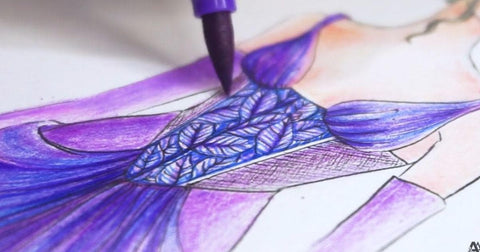Unleashing a Symphony of Ink: Mastering the Art of Calligraphy
Last Updated: July 29, 2024

Hey, fellow creative souls! Today, we're diving into the enchanting world of calligraphy, where every stroke is a dance and every letter a note in a symphony of ink.
So, grab your favorite pen, roll up your sleeves, and let's explore the secrets of crafting those swoon-worthy swirls and elegant loops.
What Is Calligraphy?
Calligraphy is the art of beautiful writing, a visual expression of language that transcends the mere conveyance of words.
Rooted in diverse cultures and traditions, calligraphy transforms the act of writing into a form of artistic expression. It emphasizes the aesthetic qualities of letters, characters, and symbols, often employing a variety of tools and techniques to create visually harmonious and pleasing compositions.

Photo courtesy of Niketh Vellanki on Unsplash
In calligraphy, skilled practitioners meticulously craft letters and symbols using pens, brushes, or other writing instruments. The emphasis lies not only in the accuracy of the written forms but also in the fluidity, balance, and artistic embellishments applied to each stroke.
Over the centuries, various calligraphic styles have emerged, each with its own rules and aesthetics, ranging from the classical and ornate to the modern and expressive.
Calligraphy exists in various cultural and historical contexts, including Chinese, Japanese, Arabic, Persian, and Western traditions. Religious texts, manuscripts, official documents, and artistic creations employ it.
While traditional calligraphy often adheres to established scripts, contemporary calligraphers may experiment with new styles, blending the old with the new to create innovative and personal expressions of the written word.

Read More About the Revival of Traditional Artforms in This Blog Post
Diving Into the Diverse Styles of Calligraphy
Calligraphy is a diverse universe with various styles waiting to be explored. Whether you're drawn to the classic elegance of Copperplate or the bold strokes of Gothic, don't be afraid to experiment. Your unique voice will emerge as you find the style that resonates with your artistic spirit.

Photo courtesy of Samir Bouaked on Unsplash
Here are some of the more prominent calligraphy styles:
1. Uncial
Originating in ancient Rome, Uncial is a rounded and often majuscule (all capital letters) script. It gained popularity in early Christian manuscripts.
2. Blackletter (Gothic)
Recognizable for its bold, angular, and dense appearance, Blackletter, or Gothic script, was widely used in medieval Europe. It has a distinctive look with elaborate swirls and sharp angles.
3. Copperplate
Known for its graceful and flowing curves, Copperplate is a pointed pen script that emerged in the 18th century. It's characterized by its slanted letterforms and is often associated with formal and elegant writing.
4. Spencerian
Developed by Platt Rogers Spencer in the 19th century, the Spencerian script is a graceful and ornamental style of penmanship. It served as a popular form of handwriting in the United States during the late 1800s.
5. Italic
Italic is a slanted script that originated in Italy during the Renaissance. It is known for its simple, legible, and elegant design. Italic has both formal and informal variations.
6. Brush Calligraphy
Modern and dynamic, brush calligraphy is created with a brush or brush pen, allowing for expressive and varied strokes. It is often used in East Asian calligraphy traditions, such as Chinese and Japanese.
7. Modern Calligraphy
This style is a contemporary and eclectic approach to calligraphy, often characterized by a mix of traditional letterforms and more relaxed, free-flowing elements. Modern calligraphy embraces individual expression and experimentation.
8. Roman Capitals
Rooted in ancient Roman inscriptions, Roman Capitals are majuscule letters with clean, geometric shapes. This classic style exudes a sense of timeless elegance.
9. Carolingian
Developed during the Carolingian Renaissance in the 8th century, this script is characterized by its clear, legible letterforms. Carolingian script influenced the development of later medieval and Renaissance scripts.
10. Arabic Calligraphy
An integral part of Islamic art and culture, Arabic calligraphy is a highly ornamental and expressive form of writing. It features intricate designs and is often used for religious and artistic purposes.
Tips and Tricks to Master the Art of Calligraphy
1. Choose Your Weapon Wisely.

The first step on this calligraphic journey is selecting the perfect pen. Whether you opt for a classic dip pen with nibs or a sleek, modern fountain pen, the key is finding a writing tool that feels like an extension of your hand. It's like choosing a wand at Ollivander's – let the pen choose you.
2. Paper Matters, Too.
Just as a painter selects the right canvas, a calligrapher must find the perfect paper. Smooth surfaces work wonders for maintaining the fluidity of your strokes, ensuring that your letters glide across the page like poetry on a breeze. Think of it as a tactile love affair between pen and paper.

3. Follow the ABCs of Consistency.
Calligraphy is the master of consistency. Work on maintaining uniformity in your letter sizes and spacing. Imagine your letters are part of an elaborate dance troupe – each one has its role, but together, they create a seamless performance.
4. Embrace the Flourish.
Don't be afraid to let your letters dance with a flourish! Those elegant curls and loops are the heartbeats of your composition. Experiment with different flourishes until your letters feel like they're ready to waltz off the page.

5. Mind Your Posture.
Calligraphy is a sensual experience that starts with the way you hold your pen. Adopt a relaxed posture, with your feet firmly planted and your back straight. Let your hand float effortlessly across the page, conducting the ink orchestra to create a masterpiece.
6. Patience is a Virtue.
Like any art form, calligraphy demands patience. Rome wasn't built in a day, and neither is a stunning calligraphic piece. Take your time with each stroke, savoring the rhythm of the ink as it meets the paper. It's not a race; it's a slow, deliberate dance.

7. Learn from the Masters
In the world of calligraphy, wisdom is passed down through the ages. Study the works of calligraphic maestros, from ancient scribes to modern lettering wizards. Let their strokes guide and inspire you, as you weave their legacy into your artistic tapestry.
Practice Your Calligraphy with an Art Journal! Learn How to Make One Here.
Let Your Brushes and Pens Dance

So there you have it – a symphony of tips and tricks to unlock the magic of calligraphy. Remember, there are no mistakes in this dance, only opportunities to improvise. Embrace the journey, let the ink flow, and watch as your letters pirouette into the realm of timeless beauty.
For more inspiration, ideas, and tips, you’re always welcome to The Creative Corner. Happy lettering, friends! 🖋✨






